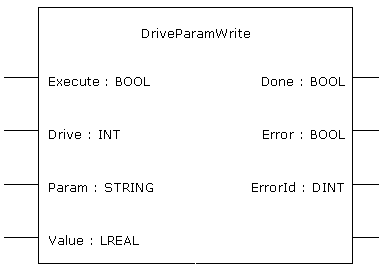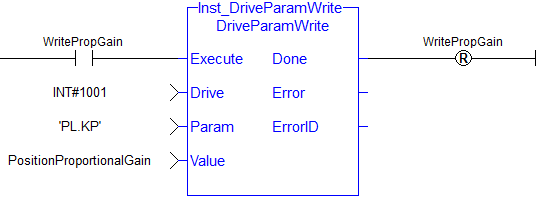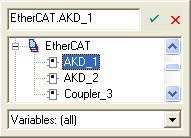 DriveParamWrite
DriveParamWrite

Description
This function block writes a drive parameter by sending an ASCII command to a drive.
It takes multiple cycles to complete this function block. Typically only oneDriveParamRead or DriveParamWrite function should be active for each axis at one time. If executing this function block continuously or multiple times is required, add code that waits for this function block to complete (Done bit = 1) before executing it again, as shown in DriveParamRead.
See also some stats about the execution time here.

-
-
This function block uses and reserves the EtherCAT
 ***EtherCAT is an open, high-performance Ethernet-based fieldbus system. The development goal of EtherCAT was to apply Ethernet to automation applications which require short data update times (also called cycle times) with low communication jitter (for synchronization purposes) and low hardware costs SDO Channel. The SDO Channel will remain reserved until the done output is "true". Therefore, this FB should be called at each cycle until the done output is true. If it is not called at each cycle the rest of SDO communication (the AKD GUI
***EtherCAT is an open, high-performance Ethernet-based fieldbus system. The development goal of EtherCAT was to apply Ethernet to automation applications which require short data update times (also called cycle times) with low communication jitter (for synchronization purposes) and low hardware costs SDO Channel. The SDO Channel will remain reserved until the done output is "true". Therefore, this FB should be called at each cycle until the done output is true. If it is not called at each cycle the rest of SDO communication (the AKD GUI "Graphical User Interface"
A GUI is a type of user interface which allows people to interact with a computer and computer-controlled devices Views, for example) will be blocked.
"Graphical User Interface"
A GUI is a type of user interface which allows people to interact with a computer and computer-controlled devices Views, for example) will be blocked. Using this FB in SFC
 "Sequential function chart"
It can be used to program processes that can be split into steps.
The main components of SFC are:
- Steps with associated actions
- Transitions with associated logic conditions
- Directed links between steps and transitions P0 or P1 steps is not recommended as these steps are executed only once. If this FB is used in P0 or P1 then it must be used in an SFC N step to ensure the FB completes.
"Sequential function chart"
It can be used to program processes that can be split into steps.
The main components of SFC are:
- Steps with associated actions
- Transitions with associated logic conditions
- Directed links between steps and transitions P0 or P1 steps is not recommended as these steps are executed only once. If this FB is used in P0 or P1 then it must be used in an SFC N step to ensure the FB completes.
Arguments
Input
|
Execute |
Description |
On the rising edge |
|
Data type |
BOOL |
|
|
Range |
0, 1 |
|
|
Unit |
N/A |
|
|
Default |
— |
|
|
Drive |
Description |
The address of the drive to which data is written to. The first node usually has the value '1001'. The second node usually has the value '1002'. Alternately, you can use the members of the EtherCAT structure to specify a drive's address when you create the variable.
|
|
Data type |
INT |
|
|
Range |
— |
|
|
Unit |
N/A |
|
|
Default |
— |
|
|
Param |
Description |
The parameter to write. |
|
Data type |
STRING |
|
|
Range |
— |
|
|
Unit |
N/A |
|
|
Default |
— |
|
|
Value |
Description |
The value to set the drive parameter to. |
|
Data type |
LREAL |
|
|
Range |
— |
|
|
Unit |
N/A |
|
|
Default |
— |
Output
| Done | Description |
Indicates whether the DriveParamWrite function block has completed without error. |
| Data type |
BOOL |
|
| Unit |
N/A |
|
| Error |
Description |
Indicates whether the DriveParamWrite function block call has completed with error. |
|
Data type |
BOOL |
|
|
Unit |
N/A |
|
| ErrorID |
Description |
The DriveParamWrite error result if Error is TRUE (see Upon success, Error is set to zero. |
|
Data type |
DINT |
|
|
Unit |
N/A |
Table 7-46: List of EtherCAT Error Codes
Usage
The function block can be used to change drive parameters. Common examples include tuning parameters and changing drive limits such as peak current.
Related Functions
Example
Structured Text
(* Write 58.000 to PL.KP of first AKD Dri
ve on Ethe
rCAT network *)
Inst_DriveParamWrite( TRUE, 1001, 'PL.KP', 58 );
FBD

FFLD


 [Top]
[Top]





